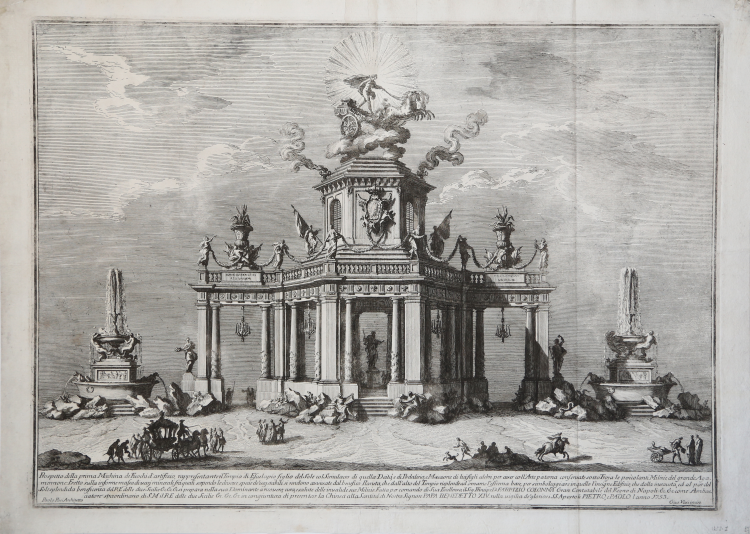



| Reference: | S41811 |
| Author | Giuseppe VASI |
| Year: | 1753 |
| Measures: | 568 x 405 mm |


| Reference: | S41811 |
| Author | Giuseppe VASI |
| Year: | 1753 |
| Measures: | 568 x 405 mm |
Etching, printed on contemporary laid paper, small abrasions, otherwise in good condition
The engravings have been laid on canvas and framed; after a long work to repair them, they now look almost perfect. Signs of glue on verso, on recto signs of abrasions and oxidations.
Chinea literally means white female mule, the one the Kings of Spain offered every year to the Pope as a solemn payment of the income of the Kingdome of Naples. The horse, duly trained, knelt in front of the Pope and to offer him a silver vase with money inside, that was fastened to its saddle.
The offer was preceded by a solemn ride of two and a half hours, a long and precise itinerary. To make it even more solemn, as per Charles II decree of the 12 of May 1691, the Greats of Spain were obliged to take part to the cortege, which was then followed by two series of pyrotechnical shots and music, dances and food. The chinea, due to its reiteration, was not only the most important summer party, but was even the best way for the Spanish monarchy to present itself in Rome, the best promotional campaign to gain universal consent and political support from the other monarchies.
The celebration was massive, notwithstanding the political problems and the late remittance to pay it. When the celebration was organized, and even after that, Palazzo Colonna and Palazzo Farnese became for two months the workshops for inventors, painters, drawers, architects and even pyrotechnists, musicians, suppliers and cooks. These Palazzi became also, for two days, the extraordinary embassy, the starting point of the solemn ride and in front of which the “fabulous” pyrotechnical machines shot their fireworks, where all the light were lightened on the eve and the very day of the celebration of St. Peter and St. Paul. The tradition of building the fireworks machines in the square of Santissimi Apostoli, on the 28 and the 29 of June, was started in the XVIII century (just sometimes in piazza Farnese); all we know about this habit derives from the detailed engravings and the texts that have been printed yearly, starting from 1723.
Paolo Posi, architect of the Venetian Republic and of the Colonna Family, and his scholar Giuseppe Palazzi, together with Giuseppe Vasi, literally monopolized the art of building these machines. Posi, the last baroque artist, celebrated King Ferdinando in his creations and the King was absolutely enthusiastic about offering this public spectacular performance.
Vasi was, on the other side, an important witness and interpreter of his own time. The set of engravings we present here comes from a Roman collection.
The bibliography mentions 45 different works of Vasi dedicates to the pyrotechnical machines.
Giuseppe VASI (Corleone, 27 Agosto 1710 - Roma, 16 Aprile 1782)
|
Italian engraver and painter. After completing a classical education, he trained as a printmaker in Palermo, possibly at the Collegio Carolino, which was founded by the Jesuit Order in 1728 and at which the etcher Francesco Ciché ( fl before 1707; d Palermo, 1742) was a teacher. Vasi was already an accomplished engraver when, in 1736, he contributed to the illustration of La reggia in trionfo by Pietro La Placa, which described the festivities held in Palermo to mark the coronation of Charles VII of Naples (the future Charles III of Spain). That same year Vasi moved to Rome, where, as a Neapolitan subject, he was immediately afforded the protection of the ambassador, Cardinal Troiano Aquaviva d’Aragona (1694–1747). In Rome he met other artists who worked for the same patron: Sebastiano Conca, Luigi Vanvitelli and Ferdinando Fuga. It is against this background that Vasi’s work in Rome, when he was in residence at the Palazzo Farnese, should be considered: his monopoly as the engraver of the Roman records of the monarch, the plates for the festivals of the ‘Chinea’ and the triumphal arches erected in front of the Palatine gardens on the occasion of temporal sovereignty over Rome
|
Giuseppe VASI (Corleone, 27 Agosto 1710 - Roma, 16 Aprile 1782)
|
Italian engraver and painter. After completing a classical education, he trained as a printmaker in Palermo, possibly at the Collegio Carolino, which was founded by the Jesuit Order in 1728 and at which the etcher Francesco Ciché ( fl before 1707; d Palermo, 1742) was a teacher. Vasi was already an accomplished engraver when, in 1736, he contributed to the illustration of La reggia in trionfo by Pietro La Placa, which described the festivities held in Palermo to mark the coronation of Charles VII of Naples (the future Charles III of Spain). That same year Vasi moved to Rome, where, as a Neapolitan subject, he was immediately afforded the protection of the ambassador, Cardinal Troiano Aquaviva d’Aragona (1694–1747). In Rome he met other artists who worked for the same patron: Sebastiano Conca, Luigi Vanvitelli and Ferdinando Fuga. It is against this background that Vasi’s work in Rome, when he was in residence at the Palazzo Farnese, should be considered: his monopoly as the engraver of the Roman records of the monarch, the plates for the festivals of the ‘Chinea’ and the triumphal arches erected in front of the Palatine gardens on the occasion of temporal sovereignty over Rome
|